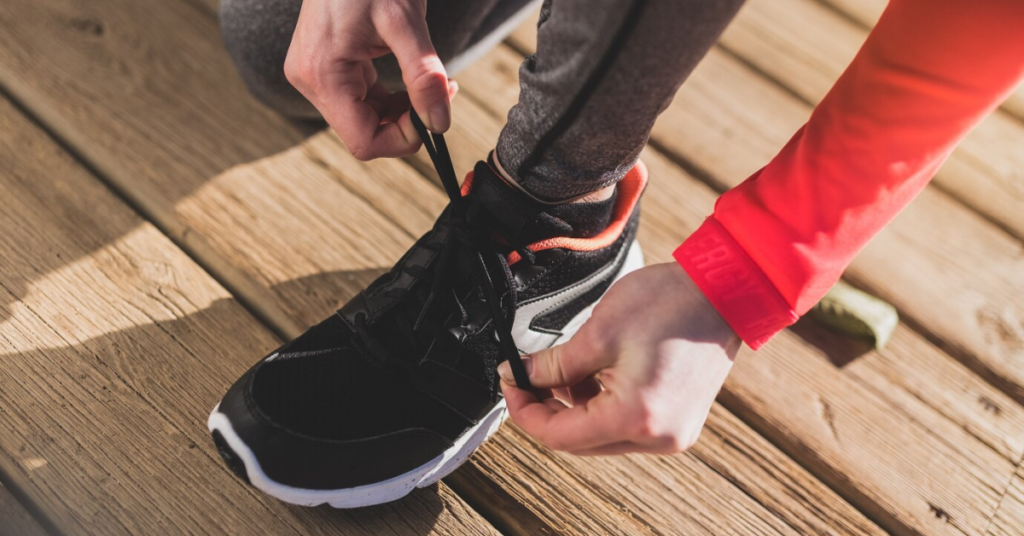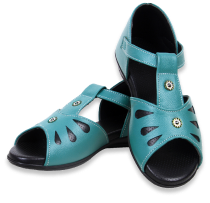Diabetes is a condition that requires constant vigilance, especially when it comes to managing blood sugar levels. However, one of the most overlooked aspects of diabetes care is foot health. High blood sugar levels can lead to a range of complications, including nerve damage (neuropathy) and poor circulation, both of which can make the feet particularly vulnerable to injuries, infections, and even amputations. For those with diabetes, proper foot care is not just a precaution; it’s a necessity. Yet, many people with diabetes underestimate the importance of wearing the right footwear. The consequences of ignoring foot health can be severe, but there’s a simple solution: diabetic footwear.
Diabetic footwear is specially designed to address the unique needs of people with diabetes. These shoes offer more than just comfort—they provide essential protection that regular shoes cannot match. By wearing diabetic footwear, you can significantly reduce your risk of developing serious foot complications, maintain your mobility, and improve your overall quality of life. In this article, we will explore the many benefits of diabetic footwear and explain why it’s a crucial part of managing diabetes.
The Unique Challenges of Diabetic Feet
Before diving into the benefits of diabetic footwear, it’s important to understand the specific challenges that people with diabetes face when it comes to foot health. Diabetes can lead to several issues that increase the risk of foot problems:
- Nerve Damage (Neuropathy): High blood sugar levels can damage the nerves in your feet, leading to a loss of sensation. This means you might not feel pain, heat, or cold in your feet, making it easy to overlook injuries like cuts, blisters, or sores.
- Poor Circulation: Diabetes can cause blood vessels to narrow and harden, reducing blood flow to the feet. Poor circulation slows down the healing process, making it more difficult for even minor injuries to heal properly.
- Increased Risk of Infections: Due to reduced sensation and poor circulation, injuries can go unnoticed and untreated. This increases the risk of infections, which can quickly escalate into more serious complications.
- Foot Deformities: Over time, diabetes can lead to foot deformities such as bunions, hammertoes, and Charcot foot. These deformities can make it difficult to find shoes that fit properly, increasing the risk of pressure points and injuries.
Given these challenges, it’s clear that people with diabetes need footwear that offers more than just basic protection. This is where diabetic footwear comes in.
The Core Benefits of Diabetic Footwear
Diabetic footwear is designed with the specific needs of diabetic feet in mind. Here are some of the key benefits that make these shoes essential for anyone living with diabetes:
- Enhanced Comfort and Fit: Diabetic footwear is designed to accommodate the unique shape and size of diabetic feet. These shoes typically offer extra depth and width to ensure a comfortable fit, even for those with foot deformities or swelling. The interior of diabetic shoes is often seamless, which helps prevent friction and reduces the risk of blisters, calluses, and other injuries.
- Protection Against Injuries: One of the most important features of diabetic footwear is its ability to protect the feet from injuries. The shoes are made from soft, durable materials that provide a protective barrier against external hazards. Additionally, diabetic shoes often have a roomy toe box, which prevents pressure on the toes and reduces the risk of developing ulcers or other foot problems.
- Improved Circulation: Diabetic shoes are designed to promote better blood flow to the feet. They often feature cushioned insoles and outsoles that distribute pressure evenly across the foot, reducing the strain on specific areas. Some shoes even have special designs that encourage natural foot movement, further enhancing circulation and reducing the risk of foot complications.
- Reduced Risk of Infection: The interiors of diabetic shoes are often treated with antimicrobial materials to help prevent the growth of bacteria and fungi. This is particularly important for people with diabetes, as their immune systems may be compromised, making them more susceptible to infections.
- Customizable Options: Diabetic footwear is available in a range of styles and can often be customized to meet the specific needs of the wearer. For example, some shoes come with removable insoles that can be replaced with custom orthotics. Others offer adjustable straps or closures to accommodate swelling or other foot issues. This level of customization ensures that each pair of shoes provides the perfect fit and the right level of support.
- Durability and Longevity: Diabetic shoes are built to last. The materials used in these shoes are not only soft and comfortable but also durable enough to withstand daily wear and tear. Investing in a quality pair of diabetic shoes can provide long-term protection for your feet, reducing the need for frequent replacements.
The Risks of Ignoring Proper Footwear
Failing to wear appropriate footwear can lead to serious complications for people with diabetes. Here are some of the risks associated with neglecting foot care:
- Foot Ulcers: Foot ulcers are one of the most common complications of diabetes, and they can be difficult to treat. These open sores develop when pressure points on the feet break down, leading to wounds that are slow to heal. Without the right footwear, minor injuries can quickly escalate into ulcers, increasing the risk of infection.
- Infections: Because people with diabetes often have reduced sensation in their feet, they may not notice when an injury occurs. This allows infections to develop and spread, sometimes leading to severe consequences like gangrene. Diabetic shoes help prevent injuries and reduce the risk of infections by providing a protective barrier.
- Amputations: In extreme cases, untreated foot ulcers or infections can lead to amputations. According to the American Diabetes Association, people with diabetes are at a significantly higher risk of limb amputations compared to those without the condition. Wearing diabetic footwear can play a crucial role in preventing these life-altering outcomes.
- Decreased Mobility: Foot pain or injuries can severely limit your ability to move around, impacting your overall health and well-being. Staying active is a key part of managing diabetes, and without proper footwear, you may find it difficult to maintain your mobility.
- High Medical Costs: Treating complications related to foot problems can be expensive. Hospitalizations, surgeries, and long-term care are costly, both financially and emotionally. Investing in diabetic footwear is a cost-effective way to prevent these complications and avoid unnecessary medical expenses.
How Diabetic Footwear Supports Overall Health
Diabetic footwear is more than just a tool for protecting your feet—it’s an investment in your overall health. Here’s how the right footwear can benefit your health in the long term:
- Prevention of Complications: The primary benefit of diabetic footwear is its ability to prevent complications before they arise. By reducing pressure points, improving circulation, and providing protection against injuries, these shoes help you avoid the serious health issues that can result from poor foot care.
- Improved Comfort and Mobility: Comfort is crucial for staying active, and diabetic footwear delivers on this front. By providing a proper fit and ample cushioning, these shoes reduce foot pain and make it easier to move around. Whether you’re walking, exercising, or just going about your daily routine, diabetic footwear helps you stay on your feet.
- Long-Term Cost Savings: While diabetic footwear may have a higher upfront cost than regular shoes, it can save you money in the long run. By preventing complications that require expensive treatments, hospital stays, or surgeries, these shoes offer significant cost savings over time.
- Enhanced Quality of Life: When your feet are comfortable and pain-free, it’s easier to enjoy life. Diabetic footwear helps you maintain your independence and stay engaged in the activities you love. Whether it’s spending time with family, traveling, or pursuing hobbies, the right footwear can make all the difference.
- Peace of Mind: Knowing that your feet are well-protected can provide peace of mind. You won’t have to worry about small injuries turning into big problems, allowing you to focus on managing other aspects of your diabetes. Diabetic footwear helps you stay proactive about your health, giving you the confidence to live life to the fullest.
Selecting the Right Diabetic Footwear
Choosing the right diabetic footwear is crucial for ensuring that you receive all the benefits these shoes have to offer. Here are some tips for selecting the best footwear for your needs:
- Consult with a Professional: Before purchasing diabetic footwear, it’s a good idea to consult with a healthcare professional, such as a podiatrist. They can assess your foot health, recommend specific features, and even prescribe custom orthotics if necessary.
- Focus on Fit: A proper fit is essential for preventing foot problems. Diabetic shoes should offer enough room for your toes, provide extra depth, and avoid any tight spots that could cause pressure points. Make sure to try on shoes later in the day when your feet are slightly swollen, as this will give you a better sense of how they will fit during daily wear.
- Consider Your Activity Level: Different types of diabetic shoes are designed for different levels of activity. If you’re active and spend a lot of time on your feet, look for shoes with extra cushioning and support. If you’re more sedentary, you may prioritize other features, such as ease of use or lightweight materials.
- Look for Customization Options: If you have specific foot issues, such as bunions or hammertoes, look for shoes that can be customized with orthotic inserts or additional padding. Some diabetic shoes offer removable insoles that can be replaced with custom options.
- Prioritize Durability: Diabetic footwear is an investment, so choose shoes that are built to last. Look for high-quality materials and construction that will stand up to daily wear and tear







